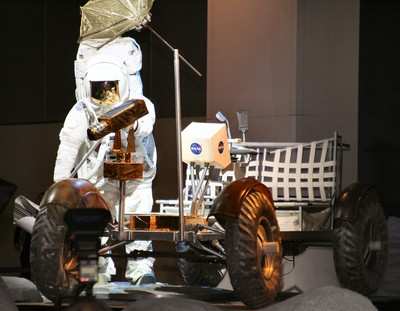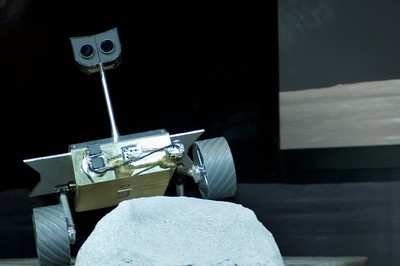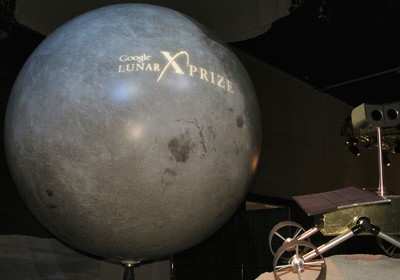10 Teams Registered For $30 Million Google Lunar X Prize
The X Prize Foundation and Google, Inc. announced Thursday the
first 10 teams to register for the Google Lunar X Prize, a robotic
race to the Moon to win $30 million in Prizes. This international
group of teams will compete to land a privately funded robotic
craft on the Moon that is capable of roaming the lunar surface for
at least 500 meters and sending video, images and data back to the
Earth.

Dr. Peter H. Diamandis, Chairman and CEO of the X Prize
Foundation, announced the teams at Google Headquarters in Mountain
View, CA.
"I'm very pleased to welcome our first 10 fully registered teams
to the Google Lunar X Prize," Diamandis said. "Only six months
after the announcement of this competition, the response has been
incredible -- we've received over 567 expressions of interest from
53 nations. By comparison, at the six-month point of the Ansari X
Prize we had only two teams registered. I think we're going to see
an exciting and very competitive race to the Moon, highlighted by
some very creative designs unlike anything we've seen come out of
the government space programs.
"Many of these teams represent some of the most creative and
entrepreneurial minds in space exploration today," he added. "I
wish them all the very best of luck. I can't wait to join with
Google in paying the winner."

"We are excited that 10 teams from around the world have taken
up the challenge of the Google Lunar X Prize," said Megan Smith,
Google's Vice President for New Business Development. "We look
forward to the exciting achievements and scientific advancements
that will result from the efforts of these teams as they
participate in the next great space race."
The 10 teams are:
- Aeronautics and Cosmonautics Romanian Association
(ARCA): Based in Valcea, Romania and led by Dumitru
Popescu, ARCA was also a contender in the Ansari X Prize. Two of
ARCA's most innovative projects to date have been the Demonstrator
2B rocket and Stabilo, a two-stage manned suborbital air-launched
vehicle. The craft they plan to enter in the Google Lunar X Prize
will be called the "European Lunar Explorer."
- Astrobotic: Team Astrobotic, led by Dr.
William "Red" Whittaker, was formed to coordinate the efforts of
Carnegie Mellon University, Raytheon Company and additional
institutions. One of Carnegie Mellon's specialties is autonomous
navigation through stereo vision and other technologies. This
enables Carnegie Mellon's robots to automatically avoid obstacles
and select their own route across unmapped terrain. Astrobotic will
compete for the Prize using their "Artemis Lander" and "Red
Rover."

- Chandah: Chandah, meaning "Moon" in Sanskrit,
was founded by Adil Jafry, an energy industry entrepreneur. He is
now chairman and CEO of Tara, the largest independent retail
electricity provider in Texas. Jafry's goal is to catalyze
commercialization of space, and bring advances in space travel,
tourism, sciences, and technology to the general public at large.
Team Chandah's spacecraft will be named "Shehrezade."
- FREDNET: Headed by Fred J. Bourgeois III, this
multi-national team is comprised of systems, software, and hardware
developers who serve as the leaders and overall coordinators of an
international group of Open Source developers, engineers, and
scientists. Their goal is to bring the same successful approach
used in developing major software systems (such as the Internet,
and Linux) to bear on the problems associated with Space
Exploration and Research.
- LunaTrex: Led by Pete Bitar, LunaTrex is
comprised of several individuals, companies, and universities from
all over the United States, some of whom were also competitors for
the Ansari X Prize. Each team member brings their own history to
the mix: rocket science, high-altitude near-space R&D, defense
directed-energy technology, aviation design and development,
robotics, trajectories, and non-conventional propulsion expertise.
The name of their competing craft will be "Tumbleweed."
- Micro-Space: Helmed by Richard Speck and based
in Colorado, Micro-Space, Inc. has a 31-year history of producing
world class, high tech products. Since focusing on the development
of spaceflight systems, they have flown 17 innovative, bipropellant
liquid fuel rockets, three near-hover rockets with vectored thrust
guidance, scores of flights with telemetry and radio tracking, and
several innovative life support systems. Micro-Space has been a
competitor in the Ansari X Prize as well as the Northrop Grumman
Lunar Lander Challenge. Their "Human Lunar Lander" will compete for
Google Lunar X Prize.

- Odyssey Moon: The first team to register for
the competition, Odyssey Moon is a private commercial lunar
enterprise headquartered in the Isle of Man and founded by Dr.
Robert Richards. Odyssey Moon's business plans are actively in
development for a series of missions to the Moon during the
International Lunar Decade in support of science, exploration and
commerce. Their Google Lunar X Prize craft is titled "MoonOne
(M-1)."
- Quantum3: A US-based team, Quantum3 is led by
Paul Carliner, a senior executive in the aerospace industry. They
propose to field a small spacecraft launched from an East Coast
range using launch-coast-burn trajectory for a propulsive soft
landing on the surface of the Moon at the Sea of Tranquility.
Quantum3 is taking a partnership approach to the mission, utilizing
the unique capabilities of the private sector and academic
communities. Their craft will be called "Moondancer."
- Southern California Selene Group: According to
team leader Harold Rosen, the approach taken by the Santa Monica
Selene Group can be succinctly summarized as "an elegantly simple
design that is relatively inexpensive to implement." The
architecture for their "Spirit of Southern California" spacecraft
will combine the control and communication systems used in some of
the earliest communications satellites with the latest in
electronic and sensor technology.
- Team Italia: Based in Italy and led by Prof.
Amalia Ercoli-Finzi, Team Italia is a collaboration between several
universities. The team is currently running a prototype of its
system at Politecnico di Milano. The architecture of the robotic
system is under study: a single big rover or a colony of many
robots, light and mobile, with many legs and wheels, able to be
compacted in the lander and distributed quickly on the Moon's
surface with cameras and sensory support.

The X Prize Foundation has also announced that Space Florida
will be a new preferred partner and the first preferred launch site
for the $30 million Google Lunar X Prize competition. Each
preferred partner offers additional Prizes or strategic services at
a discounted rate to all competition teams. As the first preferred
launch site, Space Florida will award an additional prize of $2
million to the Grand Prize winner of the Google Lunar X Prize
competition, provided the winner launched the winning flight from
the State of Florida and upon confirmation that the winner has
complied with all competition rules.
Space Florida was created by the Florida Legislature to sustain
Florida's position as the global leader in space exploration and
commerce, and is the principal organization charged with promoting
and developing Florida's aerospace industry.

As ANN has reported, the $30
million prize purse is segmented into a $20 million Grand Prize, a
$5 million Second Prize and $5 million in bonus Prizes. To win the
Grand Prize, a team must successfully soft land a privately funded
spacecraft on the Moon, rove on the lunar surface for a minimum of
500 meters, and transmit a specific set of video, images and data
back to the Earth.
The Grand Prize is $20 million until December 31, 2012;
thereafter it will drop to $15 million until December 31, 2014 at
which point the competition will be terminated unless extended by
Google and the X Prize Foundation.
 ANN's Daily Aero-Linx (04.15.24)
ANN's Daily Aero-Linx (04.15.24) Classic Aero-TV: 'No Other Options' -- The Israeli Air Force's Danny Shapira
Classic Aero-TV: 'No Other Options' -- The Israeli Air Force's Danny Shapira Aero-News: Quote of the Day (04.15.24)
Aero-News: Quote of the Day (04.15.24) Airborne 04.16.24: RV Update, Affordable Flying Expo, Diamond Lil
Airborne 04.16.24: RV Update, Affordable Flying Expo, Diamond Lil ANN's Daily Aero-Term (04.16.24): Chart Supplement US
ANN's Daily Aero-Term (04.16.24): Chart Supplement US








